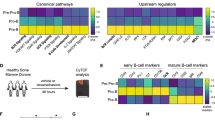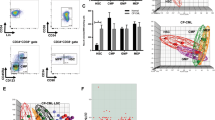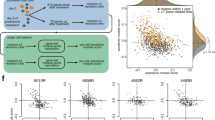Abstract
In childhood acute lymphoblastic leukemia (ALL), persistence of leukemic blasts during therapy is of crucial prognostic significance. In the present study, we address molecular and cell biologic features of blasts persisting after 1 week of induction glucocorticoid therapy. Genome-wide gene expression analysis of leukemic samples from precursor B-cell ALL patients (n=18) identified a set of genes differentially expressed in blasts at diagnosis day 0 (d0) and persisting on day 8 (d8). Expression changes indicate a shift towards mature B cells, inhibition of cell cycling and increased expression of adhesion (CD11b/ITGAM) and cytokine (CD119/IFNGR1) receptors. A direct comparison with normal B cells, which are largely therapy resistant, confirmed the differentiation shift at the mRNA (n=10) and protein (n=109) levels. Flow cytometric analysis in independent cohorts of patients confirmed both a decreased proliferative activity (n=13) and the upregulation of CD11b and CD119 (n=29) in d8 blasts. The differentiation shift and low proliferative activity in d8 blasts may account for the persistence of blasts during therapy and affect their sensitivity to further therapeutic treatment. CD11b and CD119 are potential specific markers for d8 blast persistence and detection of minimal residual disease, which warrant further investigation.
This is a preview of subscription content, access via your institution
Access options
Subscribe to this journal
Receive 12 print issues and online access
$259.00 per year
only $21.58 per issue
Buy this article
- Purchase on Springer Link
- Instant access to full article PDF
Prices may be subject to local taxes which are calculated during checkout




Similar content being viewed by others
References
Schrappe M, Reiter A, Ludwig WD, Harbott J, Zimmermann M, Hiddemann W et al. Improved outcome in childhood acute lymphoblastic leukemia despite reduced use of anthracyclines and cranial radiotherapy: results of trial ALL-BFM 90. German–Austrian–Swiss ALL-BFM Study Group. Blood 2000; 95: 3310–3322.
Reiter A, Schrappe M, Ludwig WD, Hiddemann W, Sauter S, Henze G et al. Chemotherapy in 998 unselected childhood acute lymphoblastic leukemia patients. Results and conclusions of the multicenter trial ALL-BFM 86. Blood 1994; 84: 3122–3133.
Schrappe M, Reiter A, Riehm H . Cytoreduction and prognosis in childhood acute lymphoblastic leukemia. J Clin Oncol 1996; 14: 2403–2406.
Kofler R . The molecular basis of glucocorticoid-induced apoptosis of lymphoblastic leukemia cells. Histochem Cell Biol 2000; 114: 1–7.
Lauten M, Cario G, Asgedom G, Welte K, Schrappe M . Protein expression of the glucocorticoid receptor in childhood acute lymphoblastic leukemia. Haematologica 2003; 88: 1253–1258.
Ferrando AA, Look AT . Gene expression profiling in T-cell acute lymphoblastic leukemia. Semin Hematol 2003; 40: 274–280.
Ross ME, Zhou X, Song G, Shurtleff SA, Girtman K, Williams WK et al. Classification of pediatric acute lymphoblastic leukemia by gene expression profiling. Blood 2003; 102: 2951–2959.
Willenbrock H, Juncker AS, Schmiegelow K, Knudsen S, Ryder LP . Prediction of immunophenotype, treatment response, and relapse in childhood acute lymphoblastic leukemia using DNA microarrays. Leukemia 2004; 18: 1270–1277.
Cario G, Stanulla M, Fine BM, Teuffel O, Neuhoff NV, Schrauder A et al. Distinct gene expression profiles determine molecular treatment response in childhood acute lymphoblastic leukemia. Blood 2005; 105: 821–826.
Kirschner-Schwabe R, Lottaz C, Todling J, Rhein P, Karawajew L, Eckert C et al. Expression of late cell cycle genes and an increased proliferative capacity characterize very early relapse of childhood acute lymphoblastic leukemia. Clin Cancer Res 2006; 12: 4553–4561.
Obexer P, Certa U, Kofler R, Helmberg A . Expression profiling of glucocorticoid-treated T-ALL cell lines: rapid repression of multiple genes involved in RNA-, protein- and nucleotide synthesis. Oncogene 2001; 20: 4324–4336.
Tonko M, Ausserlechner MJ, Bernhard D, Helmberg A, Kofler R . Gene expression profiles of proliferating vs G1/G0 arrested human leukemia cells suggest a mechanism for glucocorticoid-induced apoptosis. FASEB J 2001; 15: 693–699.
Wang Z, Malone MH, He H, McColl KS, Distelhorst CW . Microarray analysis uncovers the induction of the proapoptotic BH3-only protein Bim in multiple models of glucocorticoid-induced apoptosis. J Biol Chem 2003; 278: 23861–23867.
Chauhan D, Auclair D, Robinson EK, Hideshima T, Li G, Podar K et al. Identification of genes regulated by dexamethasone in multiple myeloma cells using oligonucleotide arrays. Oncogene 2002; 21: 1346–1358.
Yoshida NL, Miyashita T, U M, Yamada M, Reed JC, Sugita Y et al. Analysis of gene expression patterns during glucocorticoid-induced apoptosis using oligonucleotide arrays. Biochem Biophys Res Commun 2002; 293: 1254–1261.
Matsuyama S, Reed JC . Mitochondria-dependent apoptosis and cellular pH regulation. Cell Death Differ 2000; 7: 1155–1165.
Schmidt S, Rainer J, Riml S, Ploner C, Jesacher S, Achmuller C et al. Identification of glucocorticoid-response genes in children with acute lymphoblastic leukemia. Blood 2006; 107: 2061–2069.
Gaipa G, Basso G, Maglia O, Leoni V, Faini A, Cazzaniga G et al. Drug-induced immunophenotypic modulation in childhood ALL: implications for minimal residual disease detection. Leukemia 2005; 19: 49–56.
Bene MC, Castoldi G, Knapp W, Ludwig WD, Matutes E, Orfao A et al. Proposals for the immunological classification of acute leukemias. European group for the immunological characterization of leukemias (EGIL). Leukemia 1995; 9: 1783–1786.
Wuchter C, Ruppert V, Schrappe M, Dorken B, Ludwig WD, Karawajew L . In vitro susceptibility to dexamethasone- and doxorubicin-induced apoptotic cell death in context of maturation stage, responsiveness to interleukin 7, and early cytoreduction in vivo in childhood T-cell acute lymphoblastic leukemia. Blood 2002; 99: 4109–4115.
Karawajew L, Rhein P, Czerwony G, Ludwig WD . Stress-induced activation of the p53 tumor suppressor in leukemia cells and normal lymphocytes requires mitochondrial activity and reactive oxygen species. Blood 2005; 105: 4767–4775.
Gentleman RC, Carey VJ, Bates DM, Bolstad B, Dettling M, Dudoit S et al. Bioconductor: open software development for computational biology and bioinformatics. Genome Biol 2004; 5: R80.
Irizarry RA, Bolstad BM, Collin F, Cope LM, Hobbs B, Speed TP . Summaries of affymetrix genechip probe level data. Nucleic Acids Res 2003; 31: e15.
Scheid S, Spang R . twilight; a Bioconductor package for estimating the local false discovery rate. Bioinformatics 2005; 21: 2921–2922.
Storey JD, Tibshirani R . Statistical significance for genomewide studies. Proc Natl Acad Sci USA 2003; 100: 9440–9445.
Henderson A, Calame K . Transcriptional regulation during B cell development. Annu Rev Immunol 1998; 16: 163–200.
Milne CD, Fleming HE, Zhang Y, Paige CJ . Mechanisms of selection mediated by interleukin-7, the preBCR, and hemokinin-1 during B-cell development. Immunol Rev 2004; 197: 75–88.
Hayashi K, Nittono R, Okamoto N, Tsuji S, Hara Y, Goitsuka R et al. The B cell-restricted adaptor BASH is required for normal development and antigen receptor-mediated activation of B cells. Proc Natl Acad Sci USA 2000; 97: 2755–2760.
Janssen E, Zhu M, Zhang W, Koonpaew S . LAB: a new membrane-associated adaptor molecule in B cell activation. Nat Immunol 2003; 4: 117–123.
Merino R, Ding L, Veis DJ, Korsmeyer SJ, Nunez G . Developmental regulation of the Bcl-2 protein and susceptibility to cell death in B lymphocytes. EMBO J 1994; 13: 683–691.
Cheok MH, Yang W, Pui CH, Downing JR, Cheng C, Naeve CW et al. Treatment-specific changes in gene expression discriminate in vivo drug response in human leukemia cells. Nat Genet 2003; 34: 85–90.
Pinheiro JP, Boos J . The best way to use asparaginase in childhood acute lymphatic leukaemia – still to be defined? Br J Haematol 2004; 125: 117–127.
Hamada K, Utiyama H . Functional cytoplasmic domains of the Mac-1 integrin receptor in phorbol ester-treated U937 cells. Biochem Biophys Res Commun 2005; 335: 858–864.
Ross GD . Regulation of the adhesion versus cytotoxic functions of the Mac-1/CR3/alphaMbeta2-integrin glycoprotein. Crit Rev Immunol 2000; 20: 197–222.
Platanias LC . Mechanisms of type-I- and type-II-interferon-mediated signalling. Nat Rev Immunol 2005; 5: 375–386.
Webster JC, Huber RM, Hanson RL, Collier PM, Haws TF, Mills JK et al. Dexamethasone and tumor necrosis factor-alpha act together to induce the cellular inhibitor of apoptosis-2 gene and prevent apoptosis in a variety of cell types. Endocrinology 2002; 143: 3866–3874.
Runnebaum IB, Bruning A . Glucocorticoids inhibit cell death in ovarian cancer and up-regulate caspase inhibitor cIAP2. Clin Cancer Res 2005; 11: 6325–6332.
Carter BZ, Gronda M, Wang Z, Welsh K, Pinilla C, Andreeff M et al. Small-molecule XIAP inhibitors derepress downstream effector caspases and induce apoptosis of acute myeloid leukemia cells. Blood 2005; 105: 4043–4050.
Bhojwani D, Kang H, Moskowitz NP, Min DJ, Lee H, Potter JW et al. Biologic pathways associated with relapse in childhood acute lymphoblastic leukemia: a Children's Oncology Group study. Blood 2006; 108: 711–717.
Beesley AH, Cummings AJ, Freitas JR, Hoffmann K, Firth MJ, Ford J et al. The gene expression signature of relapse in paediatric acute lymphoblastic leukaemia: implications for mechanisms of therapy failure. Br J Haematol 2005; 131: 447–456.
Acknowledgements
We thank Rosemarie Hoffmann, Marianne Dunken and Birgit Oestereich for technical assistance, Dr Ute Ungethüm for performing the Bioanalyzer measurements and Dr Gunnar Cario for helpful discussions. Flow cytometric analysis and quantification of blast cells was a part of a collaborative study within the AIEOP-ALL-BFM MRD Study Group headed by Michael Dworzak (Vienna, Austria), Guiseppe Basso (Padua, Italy), Guiseppe Gaipa (Monza, Italy) and Richard Ratei (Berlin, Germany). This work was also supported by the Federal Ministry for Education and Research (BMBF) in the National Genome Research Network Grant 01GS0443, Wilhelm Sander Stiftung, Grant 2004.072.1 and Gutermuth Stiftung; PR was supported by Deutsche José Carreras Leukämie-Stiftung (Grant DJCLS-F05/09); SS and RS were supported by BMBF Grants 031U109/209 and 01GS0455.
Author information
Authors and Affiliations
Corresponding author
Additional information
Supplementary Information accompanies the paper on the Leukemia website (http://www.nature.com/leu)
Supplementary information
Rights and permissions
About this article
Cite this article
Rhein, P., Scheid, S., Ratei, R. et al. Gene expression shift towards normal B cells, decreased proliferative capacity and distinct surface receptors characterize leukemic blasts persisting during induction therapy in childhood acute lymphoblastic leukemia. Leukemia 21, 897–905 (2007). https://doi.org/10.1038/sj.leu.2404613
Received:
Revised:
Accepted:
Published:
Issue Date:
DOI: https://doi.org/10.1038/sj.leu.2404613
Keywords
This article is cited by
-
Dasatinib overcomes glucocorticoid resistance in B-cell acute lymphoblastic leukemia
Nature Communications (2023)
-
Reversal of glucocorticoid resistance in paediatric acute lymphoblastic leukaemia is dependent on restoring BIM expression
British Journal of Cancer (2020)
-
The proliferative history shapes the DNA methylome of B-cell tumors and predicts clinical outcome
Nature Cancer (2020)
-
Long-term results of five consecutive trials in childhood acute lymphoblastic leukemia performed by the ALL-BFM study group from 1981 to 2000
Leukemia (2010)
-
The BCL2 rheostat in glucocorticoid-induced apoptosis of acute lymphoblastic leukemia
Leukemia (2008)



